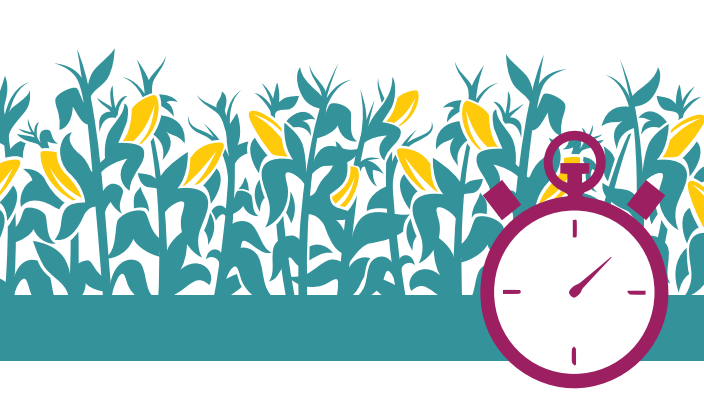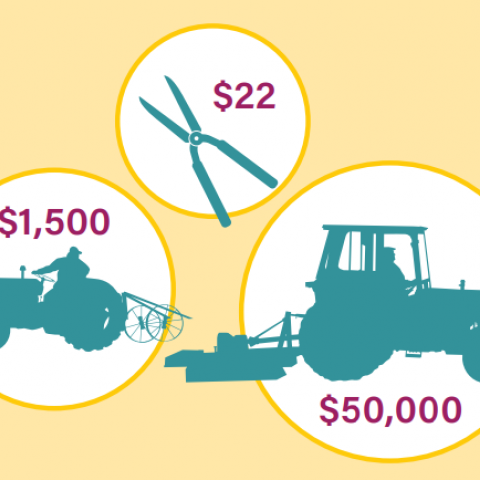
Don’t wait—harvest that corn now
1,000 acres of corn to harvest and get to market
It’s not news anymore—nor even a topic of serious debate—that Earth’s surface air temperature is rising largely because of human activities since the industrial revolution. The primary culprit is the greenhouse effect: more carbon dioxide in our atmosphere caused by burning fossil fuels and land-use conversion. That change in global surface air temperature has changed Earth’s climate. It will continue to change our climate for the foreseeable future.
The Earth has already warmed about 1.2 degrees Celsius on average. That doesn’t sound like much, but one result has been some of the hottest years ever recorded on the planet. Some places on the planet have become “inhospitable” without the aid of technology. “Inhospitable” means that the human body can’t shed heat naturally on the hottest, most humid days. This is analogous to being caught outdoors in Wisconsin in January without clothes—the body won’t last too long.
The impacts of greenhouse warming and climate change don’t stop with that example. Worse, we don’t really know how bad it could get.
To limit the extreme uncertainty associated with Earth’s climate system tumbling out of control, the best guess is to try to limit the warming by 2.0 degrees Celsius1. The general scientific consensus is that 1.5 would be better, and this number stands as the de facto goal of countries, organizations, cities, and just about anyone else trying to put forward a plan to deal with climate change.
Limiting global warming to 1.5 degrees Celsius is the basis for the Paris Climate Agreement. In 2015–2016, when Paris was adopted, the world would have had to begin reducing carbon emissions by about 7.6% per year by the year 2050 to limit warming to 1.5 degrees. However, since Paris was adopted, the accumulation of carbon dioxide in our atmosphere has continued to increase at about +1% per year. It’s not a static target.
Now, in 2021, the world will need to reduce carbon emissions by about 15% per year by 2050 to limit warming to 1.5 degrees.
This moving target to limit warming by a certain date is what I’ve often called our interest rate. An interest rate isn’t pleasant or convenient, it requires extra funds, but it’s necessary to get what you want. Imagine you spot a house that you really want to buy. You actually need that house and this house is only available to you. You’ve secured loan agreements from various sources, and the interest rate is reasonable (let’s say 7.6%), and your budget can make the payments with interest.
But you don’t buy the house. Instead, you decide to take some time to discuss with your significant other plans for moving into the house and remodeling it. In fact, instead of buying the house, you redo your move-in and remodeling plans a couple of times. Meanwhile, a sinister clause in the loan agreement takes effect. For every second you wait to buy the house, the interest rate increases. Maybe you know this, maybe you don’t. But either way, you didn’t act to buy the house when the interest rate was 7.6%—and now it’s 15%. And now, your financial position to buy the house is in peril. You’re not sure anymore if you have can afford the house. But you need the house.
What do you do?
It’s important to remember that global warming as we care about it is a direct function of the amount of carbon in the atmosphere and not the rate of emissions at one time. The rate of emissions in any given year is not particularly useful without specifying a timeline for emissions. (emissions rate X time = amount of carbon). For instance, it’s not particularly informative to say that we’ll be carbon (emissions) neutral by 2050 without knowing the rate of emissions up until 2050 and the total accumulated atmospheric carbon through 2050.
If we want to limit Earth warming to 1.5 degrees Celsius, then there has to be a finite amount of carbon we can inject into the atmosphere. This is often referred to as the global carbon budget. And it doesn’t matter if we hit the carbon budget in 2050, or 2100 for that matter. We just can’t exceed the budget.
Unfortunately, the carbon budget moves in sync with the ‘interest’ rate. Each second that goes by and we continue to insert carbon into the atmosphere, the remaining carbon budget gets smaller, and the interest rate keeps going up.
Here’s another way to look at this problem. Imagine you have 1,000 acres of corn to harvest and get to market. Nevermind how you got to this point. You’re here now. If you don’t harvest that corn and get it to market, you’ll lose your farm.
But that's not the scariest part.
What’s scarier is the uncertainty of what happens after you lose your farm, because you know this will certainly impact others in the community. Where will you live, how will you earn a living, how will you and others eat [insert any other horrible life event here]. You just don’t know what the impacts will be, because this calamity has never happened before, to anyone. No one knows what will happen to you or them. That’s what missing our climate target is like—we don’t know for sure what comes afterward.
You only have a limited time by which to harvest that corn. Landscaping shears only cost $22, but even if you bought all the shears in the store, they won’t get 1,000 acres harvested in time.
You have a lawn tractor with a rake attachment. You could quickly get another one and that will only cost $1,500. But those two tractors also can’t put 1,000 acres of corn in the barn by the deadline.

Ok, how about an agricultural tractor—say a John Deere? You don’t have one, but they only cost $50,000. You can put your house up for collateral. Oops—that’s still not enough to harvest in time.
You realize that you’ll need the largest available combine harvester—not one, but two. They cost $200,000 each. You can’t afford it, and there is no way the local bank and your neighbors will lend you that amount of money in such a short time. What do you do?
That’s where we are on climate. The technology exists. The corn is harvestable. But quit procrastinating, or we’ll need three combines to do the job.
1 Even the 2.0 number is a best guess. For sure, the climate will likely continue to change in new ways as we march toward 2.0.